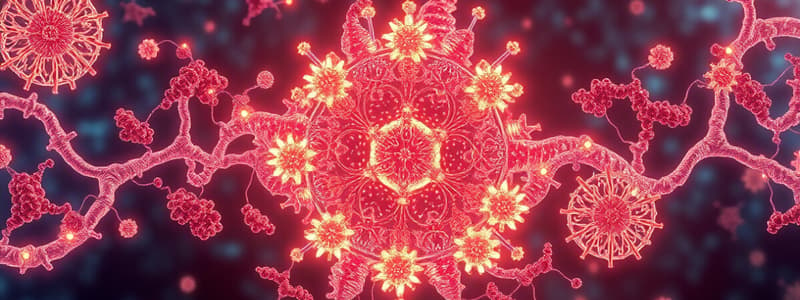Podcast
Questions and Answers
Which complex in the electron transport chain is responsible for the transfer of electrons from NADH?
Which complex in the electron transport chain is responsible for the transfer of electrons from NADH?
- Complex IV
- Complex III
- Complex II
- Complex I (correct)
How does ATP synthase utilize the proton motive force in oxidative phosphorylation?
How does ATP synthase utilize the proton motive force in oxidative phosphorylation?
- It generates heat to drive ATP production.
- It directly oxidizes NADH to produce ATP.
- It facilitates the uptake of ADP and phosphate only.
- It allows protons to flow back into the mitochondrial matrix, driving ATP synthesis. (correct)
In which cellular location does the proton gradient form in prokaryotes during oxidative phosphorylation?
In which cellular location does the proton gradient form in prokaryotes during oxidative phosphorylation?
- Within the nucleus
- Across the plasma membrane (correct)
- Inside the cytoplasm
- In the mitochondrial intermembrane space
Which statement about the electron transport chain is false?
Which statement about the electron transport chain is false?
What is the main principle of redox reactions in the electron transport chain?
What is the main principle of redox reactions in the electron transport chain?
What is the primary function of ubiquinone (Q) in the electron transport chain?
What is the primary function of ubiquinone (Q) in the electron transport chain?
In what way do prokaryotes and eukaryotes differ regarding proton gradient formation during oxidative phosphorylation?
In what way do prokaryotes and eukaryotes differ regarding proton gradient formation during oxidative phosphorylation?
Which complex in the electron transport chain is primarily responsible for the reduction of oxygen?
Which complex in the electron transport chain is primarily responsible for the reduction of oxygen?
What role does cytochrome c (cyt c) play in the electron transport chain?
What role does cytochrome c (cyt c) play in the electron transport chain?
How does ATP synthase utilize chemiosmosis in oxidative phosphorylation?
How does ATP synthase utilize chemiosmosis in oxidative phosphorylation?
What is the primary function of electron carriers such as NAD+ and FAD in cellular respiration?
What is the primary function of electron carriers such as NAD+ and FAD in cellular respiration?
Which of the following accurately describes a redox reaction?
Which of the following accurately describes a redox reaction?
During glycolysis, which of the following changes occurs in the carbon structure of glucose?
During glycolysis, which of the following changes occurs in the carbon structure of glucose?
What is the primary pathway for energy release during cellular respiration?
What is the primary pathway for energy release during cellular respiration?
What is the significance of substrate-level phosphorylation in cellular respiration?
What is the significance of substrate-level phosphorylation in cellular respiration?
In terms of energy states, how do reactants and products differ in a redox reaction?
In terms of energy states, how do reactants and products differ in a redox reaction?
What happens to carbon during the citric acid cycle?
What happens to carbon during the citric acid cycle?
Which component of cellular respiration primarily uses high-energy electrons to produce ATP?
Which component of cellular respiration primarily uses high-energy electrons to produce ATP?
Flashcards
Electron Transport Chain (ETC)
Electron Transport Chain (ETC)
A series of protein complexes embedded in the inner mitochondrial membrane that transfer electrons and release energy, driving the production of ATP.
Proton Motive Force
Proton Motive Force
The ETC generates a proton gradient across the inner mitochondrial membrane, moving protons from the matrix to the intermembrane space. This gradient represents potential energy that is used to drive ATP synthesis.
Oxidative Phosphorylation
Oxidative Phosphorylation
The process by which ATP is synthesized using the energy released from the electron transport chain. This process couples the movement of protons across the membrane to the phosphorylation of ADP.
ATP Synthase (Complex V)
ATP Synthase (Complex V)
Signup and view all the flashcards
Location of Proton Gradient Formation
Location of Proton Gradient Formation
Signup and view all the flashcards
What is ubiquinone?
What is ubiquinone?
Signup and view all the flashcards
What is cytochrome c?
What is cytochrome c?
Signup and view all the flashcards
What is the proton motive force?
What is the proton motive force?
Signup and view all the flashcards
How does ATP synthase use the proton motive force?
How does ATP synthase use the proton motive force?
Signup and view all the flashcards
Where is the proton gradient formed in eukaryotes and prokaryotes?
Where is the proton gradient formed in eukaryotes and prokaryotes?
Signup and view all the flashcards
Potential Energy in Molecules
Potential Energy in Molecules
Signup and view all the flashcards
Redox Reaction
Redox Reaction
Signup and view all the flashcards
Energy Release in Redox Reactions
Energy Release in Redox Reactions
Signup and view all the flashcards
Energy Capture Efficiency in Respiration
Energy Capture Efficiency in Respiration
Signup and view all the flashcards
Electron Carriers
Electron Carriers
Signup and view all the flashcards
Why uses a series of redox reactions?
Why uses a series of redox reactions?
Signup and view all the flashcards
Glycolysis
Glycolysis
Signup and view all the flashcards
Citric Acid Cycle
Citric Acid Cycle
Signup and view all the flashcards
Study Notes
Electron Transport Chain (ETC) Components and Steps
- ETC is a series of protein complexes embedded in the inner mitochondrial membrane (eukaryotes) or the plasma membrane (prokaryotes).
- Electrons are passed from one complex to the next, releasing energy.
- Four protein complexes (I, II, III, IV) and two mobile electron carriers (ubiquinone and cytochrome c) are involved.
- The ETC is a vital part of oxidative phosphorylation, integrating concepts from across multiple modules.
Redox Principles and Energy Release in ETC
- Redox reactions involve the transfer of electrons.
- Electrons lose energy as they move through the chain.
- This energy is used to pump protons (H+) across the membrane, creating a proton gradient.
- The process involves concepts of pH, proteins, and membranes.
Energy Coupling in ETC
- Energy is coupled between electron transfer and proton pumping.
- The energy released by electron transfer is used to actively transport protons against their concentration gradient.
- This creates a proton motive force (PMF).
ATP Synthase and Oxidative Phosphorylation
- ATP synthase is an enzyme using the proton motive force to synthesize ATP.
- Protons flow down their electrochemical gradient through ATP synthase.
- This flow drives the rotation of a part of the ATP synthase complex, which catalyzes ATP synthesis from ADP and inorganic phosphate.
- This process is known as chemiosmosis.
Location of Proton Gradient Formation
- In prokaryotes, the proton gradient is formed across the plasma membrane.
- In eukaryotes, the gradient is formed across the inner mitochondrial membrane.
- Both utilize the ETC to establish a PMF, representing a key difference in cellular location between these organisms.
Key ETC Components
- Complex I: NADH dehydrogenase, accepts electrons from NADH.
- Complex II: Succinate dehydrogenase, accepts electrons from FADH2.
- Complex III: Cytochrome bc1 complex, passes electrons to cytochrome c.
- Complex IV: Cytochrome c oxidase, transfers electrons to oxygen, generating water.
- Ubiquinone (Q): Mobile electron carrier, shuttles electrons between complexes.
- Cytochrome c (cyt c): Mobile electron carrier, shuttles electrons between complexes III and IV.
- ATP synthase (Complex V): Uses proton gradient to synthesize ATP.
Studying That Suits You
Use AI to generate personalized quizzes and flashcards to suit your learning preferences.




